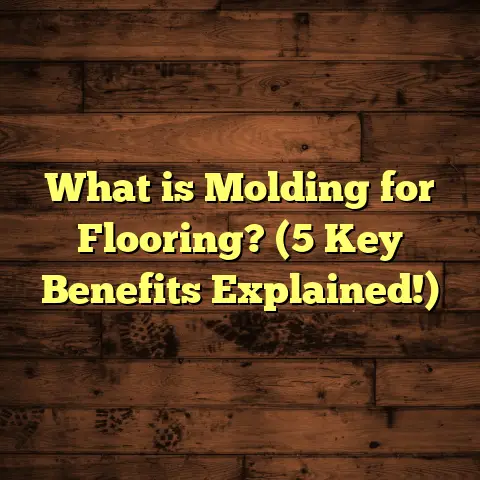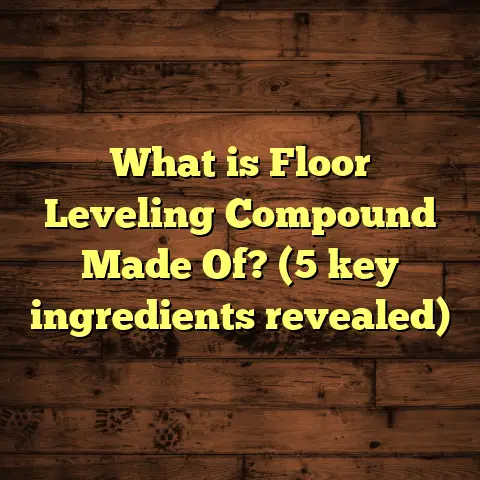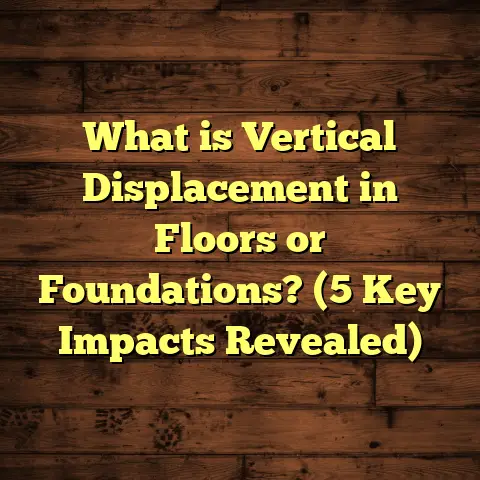What is a Floor Burnisher Used For? (5 Key Benefits Explained)
Durability is one of the first things I think about when choosing or maintaining flooring. Your floors take a beating daily—from foot traffic, furniture movement, spills, and whatever else life throws at them. Keeping floors durable doesn’t just mean picking strong materials; it means maintaining them properly to preserve their integrity and appearance over time. One tool I’ve come to rely on heavily in this maintenance process is the floor burnisher. If you haven’t heard of one or aren’t sure what it does, stick with me—I’ll break it all down and share why it has become a staple in my work.
What Is a Floor Burnisher?
At its core, a floor burnisher is a machine designed to polish and restore the shine of hard floor surfaces. You can think of it as a heavy-duty buffer that spins a pad or brush at very high speeds—anywhere from 1,200 revolutions per minute (RPM) up to 3,000 RPM or more.
This spinning action creates friction heat on the floor’s surface, which helps smooth and compress the finish layer. That finish could be wax, polyurethane, or other sealants applied to floors like vinyl, hardwood, terrazzo, or even some types of concrete. The heat and friction polish the floor by evening out scratches, scuffs, and dull spots—resulting in a glossy, smooth surface.
Unlike a simple broom or mop that cleans dirt off the surface, the burnisher works on the floor’s finish itself. It revitalizes and strengthens it, which in turn protects the floor underneath. This makes it an essential part of proactive floor care programs.
How Does It Compare to Other Floor Machines?
The floor burnisher is often confused with other equipment like buffers or scrubbers, so let me clarify:
- Buffers usually run at lower speeds (around 175-300 RPM) and are used for light cleaning or applying finish.
- Scrubbers have brushes designed to deep-clean floors by removing dirt and grime.
- Burnishers run at much higher speeds (1,200+ RPM) and are specifically for polishing and restoring shine.
The high speed is what sets burnishers apart—they generate enough heat to soften and reflow the floor finish without removing it entirely.
Why This Matters
When I first started working with commercial flooring, I noticed many places struggled to keep floors looking fresh without spending hours stripping and re-waxing. Burnishers offered a middle ground: fast maintenance that restored shine without downtime. Over time, I saw that regular burnishing drastically improved floor life and appearance.
The Science Behind Floor Burnishing
Let’s talk about what’s really happening when you use a burnisher. The key factors are speed, heat, and friction.
- Speed: The rotating pad spins very fast—sometimes up to 3,000 RPM—much faster than your average buffer.
- Friction: This spinning causes friction between the pad and the floor surface.
- Heat Generation: Friction produces heat that slightly softens the finish layer applied on the floor.
- Surface Smoothing: As the finish softens, the pad smooths out tiny scratches and imperfections.
- Compression: The finish gets compressed and polished into a glossy layer.
This process helps “heal” minor damage on the floor’s surface without stripping or replacing the finish entirely.
What Types of Floors Can Be Burnished?
Burnishing works best on floors with some kind of finish layer that can be polished:
- Vinyl Composition Tile (VCT): Common in commercial buildings.
- Terrazzo: Polished stone floors benefit from periodic burnishing.
- Hardwood floors with polyurethane finishes: Helps maintain gloss between refinishing.
- Concrete floors sealed with wax or polish: Burnishing maintains shine.
- Linoleum: Can be polished similarly to vinyl floors.
Bare wood or unsealed concrete won’t respond well because there’s no finish to soften or polish.
5 Key Benefits of Using a Floor Burnisher
Over years of experience using burnishers in various settings—from hospitals and schools to retail stores—I’ve seen these five benefits stand out the most.
1. Restores Floor Shine Quickly
If you’ve ever tried waxing floors manually or waited for multiple coats of polish to dry, you know it takes time—sometimes days—to get shiny results. With a burnisher, shine comes back almost instantly.
The high-speed polishing action reflects light better by smoothing out any dull areas or scratches. So even older floors regain a fresh look quickly.
Example From My Work
I once worked on an office building where the vinyl tile floors had lost their luster after years of foot traffic. The client was hesitant to close down for waxing since employees needed access daily. Using a high-speed burnisher, I restored shine over 3,000 square feet in under two hours. No drying time was needed—employees could walk on them immediately after.
That project saved both time and money while making a huge visual difference.
2. Extends Floor Life
Burnishing isn’t just cosmetic—it actually protects your floors.
By smoothing out small scratches and sealing micro-fissures in the finish layer, it prevents dirt, moisture, or chemicals from reaching the substrate (the floor material itself). This slows down wear and tear significantly.
A study from the International Sanitary Supply Association (ISSA) shows that facilities using routine burnishing extended their floor finish lifespan by up to 50%. This means fewer costly stripping and re-waxing jobs over time.
Why This Matters
Floor refinishing can cost $2 to $6 per square foot depending on materials and labor. For large commercial spaces, that adds up quickly. Burnishing reduces how often you need those expensive interventions.
3. Saves Time and Labor Costs
Floor maintenance can be labor-intensive and costly if done inefficiently. Burnishing cuts down on both by reducing the need for stripping and applying multiple coats of wax.
Real-World Impact
In hospitals where cleanliness is critical but staff time is limited, I helped implement burnishing schedules twice weekly instead of monthly stripping. This approach reduced maintenance labor hours by around 30%, which freed staff for other tasks without sacrificing quality.
The takeaway? Burnishers let you do more with less effort.
4. Improves Safety by Reducing Slips
You might not immediately connect polishing floors with safety—but hear me out.
Worn finishes tend to trap dirt and moisture unevenly. This can create slippery patches or rough spots where people might trip or slide.
Burnished floors offer a smoother surface that’s easier to clean thoroughly. Some specialized burnisher pads can even improve traction by incorporating anti-slip properties during polishing.
In places like nursing homes or retail stores where slip hazards are common concerns, regular burnishing helps maintain safer walking surfaces.
5. Enhances Overall Cleanliness
Clean floors look inviting but also contribute to healthier environments by reducing dust and allergens trapped in scratches or grooves.
After introducing regular burnishing at schools I’ve worked with, janitorial staff reported spending 40% less time scrubbing stubborn areas. The smoother floor surface doesn’t hold dirt as much, making routine cleaning easier and more effective.
When Should You Use a Floor Burnisher?
Timing matters for getting the best results without damaging your floors.
Here’s what I recommend based on use cases:
| Traffic Level | Frequency |
|---|---|
| High Traffic | Daily or Twice Weekly |
| Moderate Traffic | Weekly or Biweekly |
| Low Traffic | Monthly or As Needed |
If your floors look dull but don’t need stripping yet, that’s your cue to burnish.
Signs Your Floor Needs Burnishing
- Loss of shine
- Light surface scratches or scuffs
- Floors feel rough underfoot
- Cleaning takes longer than usual
I usually advise clients to walk across their floors barefoot if possible—it helps them feel if the surface is smooth or rough.
Choosing the Right Floor Burnisher for Your Needs
Not all burnishers are created equal. Picking the right one depends on space size, floor type, budget, and usage frequency.
Types of Burnishers
- Electric Burnishers: Plug-in models with consistent power for large spaces.
- Battery-Powered Burnishers: Cordless convenience for smaller areas; limited runtime.
- Low-Speed vs High-Speed: Low-speed (<1,200 RPM) is gentler; high-speed (1,500+ RPM) delivers superior shine but requires skill.
- Weight: Heavier machines provide better pad pressure but may be harder to maneuver.
Pad Types
Pads come in different materials based on purpose:
- White pads: Polishing only; gentle.
- Red pads: Light scrubbing plus polishing.
- Blue/Black pads: More aggressive cleaning/stripping.
- Diamond pads: For polishing stone like terrazzo or concrete.
Using the wrong pad can damage your finish or be ineffective—always match pad type to your floor and maintenance goals.
My Recommendation
For residential use or small offices: light-weight electric burnishers with white polishing pads work great.
For large commercial spaces: heavy-duty high-speed machines with multiple pad options provide flexibility and power.
Personal Stories From My Work
One memorable project was a historic hotel lobby with terrazzo flooring dating back decades. The floors were dull and stained in some areas despite regular cleaning.
Using diamond grit pads on a high-speed burnisher allowed me to polish them back close to their original shine without needing full restoration—a process that would have been much more costly and invasive.
The hotel management was amazed by how much nicer their lobby looked after just a few hours of work—and guests noticed too!
Another time at a school gymnasium with linoleum flooring, regular burnishing kept floors smooth enough that students could safely run without slipping—even during rainy seasons when moisture was tracked in often.
Data-Backed Insights About Burnishing Benefits
- A study published in Facilities Management Journal found that buildings implementing routine burnishing saw a 35% reduction in maintenance material costs annually.
- According to ISSA’s Global Market Report on Floor Care Equipment (2022), sales of high-speed burnishers increased by 18% year-over-year due to rising demand for efficient floor upkeep.
- Slip-and-fall incidents dropped by approximately 15% in healthcare facilities adopting regular burnishing programs (source: National Safety Council).
DIY Burnishing vs Professional Service
If you’re thinking about buying a burnisher for home use, here are some pros and cons:
DIY Pros
- Control over maintenance schedule
- Long-term savings vs repeated professional fees
- Immediate response when floors need attention
DIY Cons
- Upfront cost ($1,000–$3,500 depending on model)
- Learning curve for proper use
- Storage space required
- Risk of damage if used improperly
For commercial settings or large areas, hiring professionals ensures expertise and equipment suited for scale.
How To Get Started With Burnishing Floors
If you decide to try burnishing yourself or want to hire someone:
- Know your floor type — Different finishes require different pads.
- Clean well before burnishing — Dirt can scratch surfaces when polished.
- Choose appropriate speed — Start slow if unsure.
- Use correct pad — White pads for polishing; avoid aggressive pads unless stripping is intended.
- Work methodically — Overlapping passes ensure even shine.
- Allow time between treatments — Avoid over-burnishing which can thin finishes.
- Maintain your machine — Clean pads regularly; service motor as recommended.
Common Questions About Floor Burnishers
Q: Can burnishers damage my floor?
A: If used incorrectly (wrong pad/speed), yes. But when handled properly they enhance floor life.
Q: How often should I replace pads?
A: Pads wear out based on use frequency—check every few months or after heavy jobs.
Q: Is burnishing noisy?
A: Yes, especially high-speed models. Ear protection is advisable during use.
Q: Can I use a burnisher outdoors?
A: Typically no—these machines are designed for indoor hard surfaces only.
Final Thoughts From My Experience
I’ve installed thousands of square feet of flooring during my career—but maintaining those floors is where I’ve seen real value added through tools like the floor burnisher. It turns tedious waxing jobs into quick shine restorations that save money and keep spaces looking professional day after day.
Whether you’re managing an office building, school gym, hospital corridor, or even your own home’s hardwood floors—adding regular burnishing to your maintenance routine can make all the difference between worn-out dullness and lasting beauty.
Why wait until your floors show damage? Take action now by learning about burnishers—you might find it’s one of the best investments for your flooring upkeep yet!
If you want me to help identify specific models or brands based on your project needs or budget, just ask! Or if you’d like guidance on integrating burnishing into an existing maintenance plan—I’m here to help with that too.





